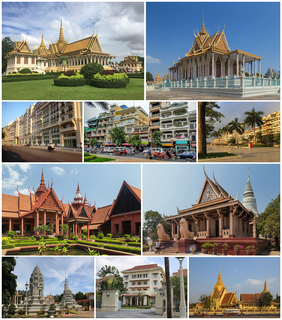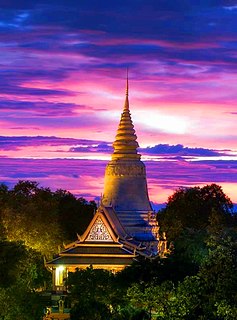Related Research Articles

Phnom Penh is the capital and most populous city of Cambodia. It has been the national capital since the French protectorate of Cambodia, and has grown to become the nation's economic, industrial, and cultural centre.

Maha Ghosananda was a highly revered Cambodian Buddhist monk in the Theravada tradition, who served as the Patriarch (Sangharaja) of Cambodian Buddhism during the Khmer Rouge period and post-communist transition period of Cambodian history. His Pali monastic name, 'Mahā Ghosānanda', means "great joyful proclaimer". He was well known in Cambodia for his annual peace marches.

Chuon Nath was a Cambodian monk and the late Gana Mahanikaya Supreme Patriarch of Cambodia. Amongst his achievements is his effort in conservation of the Khmer language in the form of the Khmer dictionary. His protection of Khmer identity and history in the form of the national anthem, "Nokor Reach" and "Pongsavotar Khmer" were also among his contributions to the country. His ashes were interred at Wat Ounalom in Phnom Penh. His full honorary title is Samdech Sangha Rāja Jhotañāno Chuon Nath

Buddhism in Cambodia or Khmer Buddhism has existed since at least the 5th century. In its earliest form it was a type of Mahāyāna Buddhism. Today, the predominant form of Buddhism in Cambodia is Theravada Buddhism. It is enshrined in the Cambodian constitution as the official religion of the country. Theravada Buddhism has been the Cambodian state religion since the 13th century. As of 2013 it was estimated that 97.9 percent of the population are Buddhists.

Wat Phnom is a Buddhist temple (wat), a pagoda, that symbolizes the name of Phnom Penh, and a historical site that is part of the Khmer national identity. Wat Phnom has a total height of 46 meters (150ft). The pagoda is named after Lady Penh from the story of the discovery of the five statues: one Vishnu statue and four Buddha statues.
Samdech Preah Agga Maha Sangharajadhipati Tep Vong is a Cambodian Buddhist monk, currently the Great Supreme Patriarch of Cambodia, known for his role in re-establishing the Cambodian monkhood after the Pol Pot period and for his links to dominant political leaders since the 1980s.

Māgha Pūjā is the second most important Buddhist festival, celebrated on the full moon day of the third lunar month in Cambodia, Laos, Thailand, Sri Lanka and on the full moon day of Tabaung in Myanmar. It celebrates a gathering that was held between the Buddha and 1,250 of his first disciples, which, according to tradition, preceded the custom of periodic recitation of discipline by monks. On the day, Buddhists celebrate the creation of an ideal and exemplary community, which is why it is sometimes called Saṅgha Day, the Saṅgha referring to the Buddhist community, and for some Buddhist schools this is specifically the monastic community. In Thailand, the Pāli term Māgha-pūraṇamī is also used for the celebration, meaning 'to honor on the full moon of the third lunar month'. Finally, some authors referred to the day as the Buddhist All Saints Day.
Theravada Buddhism is the state religion of Cambodia, which has been present since at least the 5th century.

A wat is a type of Buddhist temple and Hindu temple in Cambodia, Laos, East Shan State, Yunnan, the Southern Province of Sri Lanka and Thailand. The word wat is a Thai word that was borrowed from Sanskrit vāṭa, meaning 'enclosure'. The term has varying meanings in each region, sometimes referring to a specific type of government-recognised or large temple, other times referring to any Buddhist or Hindu temple.
Khieu Chum was a prominent Cambodian Buddhist monk and activist who was a member of a small group of people responsible for planning the Cambodian coup of 1970 which overthrew the monarchy and placed General Lon Nol as leader of a new Khmer Republic. After Cambodia achieved independence in 1953, Chum became an active figure in internal politics and is now considered one of the country's most significant political thinkers of the era.
Smot chanting, or smot is a chanting tradition performed primarily at funerals in Cambodia. It is associated with other various forms of Buddhist chanting used by Buddhism in Cambodia but distinct from both paritta chant and khatha used in Buddhist chant to proclaim the Dhammapada.

Khmer nationalism is a form of nationalism found in Cambodia, which asserts that Khmers (Cambodians) are a nation and that promotes the cultural unity of the Khmer (Cambodian) race.

Samdech Preah Mahā Somethea Dhipati Huot Tat, Dharma name: Vajirapañño, was the fifth Supreme Patriarch of the Maha Nikaya order of Cambodia.
A donchee is a pious Eight- or Ten Precepts-holding anagārikā laywoman residing in a pagoda in Buddhism in Cambodia, where bhikkhuni (nun's) lineage is not officially recognized.
An achar or achar wat is a lay Buddhist upāsaka who becomes a ritual specialist and takes on the role of master of ceremonies in various religious rites in Cambodia.

Wat Domnak is a famous Buddhist pagoda and one of the teaching monasteries in the city of Siem Reap, Cambodia.

Wat Vihear Suor is a Theravada Buddhist temple located in Kandal Province, Cambodia. It was built on an older pre-Buddhist cult site belonging to the Angkor era.
Venerable Pang Khat also known as Bhikkhu Viriyapandito was a Cambodian Theravada bikkhu monk who was notorious from 1940 to 1975 and who is most famous for his translations from Sanskrit language to Khmer.
Louis Em was an important modernist Buddhist monk who encouraged the 1942 Umbrella Revolution against the French protectorate of Cambodia, translated many major documents from Pali to Khmer. During the better part of the 20th-century, he was considered “Phnom Penh's best educated monk,” “very capable and extremely popular.”
References
- ↑ Va, Sonyka (2019-09-19). "What next? Making a major decision". Khmer Times . Retrieved 2022-04-26.
- ↑ Harris, Ian (2012-12-31). Buddhism in a Dark Age: Cambodian Monks under Pol Pot. University of Hawaii Press. ISBN 978-0-8248-6577-1.
- ↑ Seneviratne, Kalinga (2018-02-19). Mindful Communication for Sustainable Development: Perspectives from Asia. SAGE Publishing India. p. 215. ISBN 978-93-5280-554-9.
- ↑ Sen, David (2018-11-27). "Travelling to battle mental health issues". Khmer Times . Retrieved 2022-04-26.
- ↑ Srey, Kumneth (2019-06-19). "TedxRUPP 2019, launches its first event". Khmer Times . Retrieved 2022-04-26.
- ↑ Dara, Voun. "Youth, monks on Prey Lang visit". Phnom Penh Post . Retrieved 2022-04-26.
- ↑ Thida, Win (2021-09-16). "Grief, Sadness Linger After Loved Ones Die of Covid-19 Due to Funeral Restrictions". VOA. Retrieved 2022-04-26.
- ↑ "WB Finance introduces the First Charity Term Deposit, SOBOROS Account". Khmer Times . 2021-08-27. Retrieved 2022-04-26.
- ↑ Srey, Kumneth (2019-11-17). "Amazing MAM, the employer of Choice 2019". Khmer Times . Retrieved 2022-04-26.
- ↑ Sochieata, Roth. "Art show aims for convivialism converts". Phnom Penh Post . Retrieved 2022-04-26.
- ↑ "Red Cross receives donation for construction of homes for veterans". Khmer Times . 2021-10-22. Retrieved 2022-04-26.
- ↑ Elverskog, Johan (2020-01-24). The Buddha's Footprint: An Environmental History of Asia. University of Pennsylvania Press. ISBN 978-0-8122-9670-9.
- ↑ Zalinah, Noordin (2022-02-16). "Revamp of Cambodia's food ecosystem vital during pandemic". Khmer Times . Retrieved 2022-04-26.
- ↑ Yin, Soeum (2021-11-08). "Prominent monk provides guidance to youth - Khmer Times" . Retrieved 2022-04-26.
- ↑ "Family is the Core of Society: Kou Sopheap". This Life Cambodia. 2018-01-04. Retrieved 2022-04-26.
- ↑ Koemsoeun, Soth. "'Family crimes hardest to stop'". Phnom Penh Post . Retrieved 2022-04-26.
